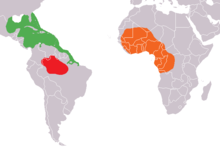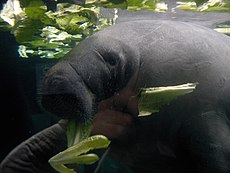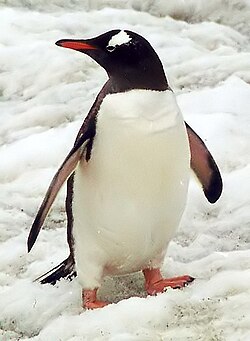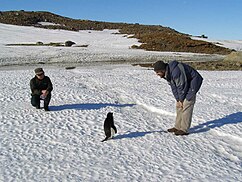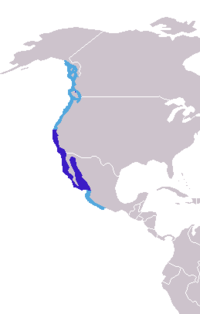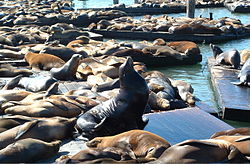Penguin
From Wikipedia, the free encyclopedia
Jump to:
navigation,
search
For other uses, see
Penguin (disambiguation).
Penguins
Fossil range:
Paleocene-Recent
Scientific classification Kingdom:
Animalia
Phylum:
Chordata
Class:
Aves
Infraclass:
Neognathae
Order:
Sphenisciformes
Sharpe, 1891 Family:
Spheniscidae
Bonaparte, 1831 Modern
genera Aptenodytes
Eudyptes
Eudyptula
Megadyptes
Pygoscelis
Spheniscus
For prehistoric genera, see
Systematics
Penguins (
order Sphenisciformes,
family Spheniscidae) are a group of
aquatic,
flightless birds living almost exclusively in the
Southern Hemisphere. Highly adapted for life in the water, penguins have
countershaded dark and white plumage, and their wings have become
flippers. Most penguins feed on
krill,
fish,
squid, and other forms of
sealife caught while swimming underwater. They spend about half of their life on land and half in the oceans.
Although all penguin species are native to the southern hemisphere, they are not found only in cold climates, such as
Antarctica. In fact, only a few species of penguin live so far south. Several species are found in the
temperate zone, and one species, the
Galápagos Penguin, lives near the equator.
The largest living species is the
Emperor Penguin (
Aptenodytes forsteri): adults average about 1.1 m (3 ft 7 in) tall and
weigh 35 kg (75 lb) or more. The smallest penguin species is the
Little Blue Penguin (also known as the Fairy Penguin), which stands around 40 cm tall (16 in) and weighs 1 kg (2.2 lb). Among extant penguins larger penguins inhabit colder regions, while smaller penguins are generally found in temperate or even tropical climates (
see also Bergmann's Rule). Some
prehistoric species attained enormous sizes, becoming as tall or as heavy as an adult human (see below for more). These were not restricted to Antarctic regions; on the contrary,
subantarctic regions harboured high diversity, and at least one giant penguin occurred in a region not quite 2,000 km south of the
Equator 35
mya, in a climate decidedly warmer than today.
Penguins seem to have no special fear of humans and have approached groups of explorers without hesitation. This is probably because penguins have no land predators in
Antarctica or the nearby offshore islands. Instead, penguins are at risk at sea from predators such as the
leopard seal. Typically, penguins do not approach closer than about 3 meters (10 ft) at which point they become nervous. This is also the distance that Antarctic tourists are told to keep from penguins (tourists are not supposed to approach closer than 3 meters, but are not expected to withdraw if the penguins come closer).
Contents
[hide]
Penguin biology
Anatomy
Orcas swim by an
iceberg with
Adélie penguins in the
Ross Sea,
Antarctica. The
Drygalski ice tongue is visible in the background.
Penguins are superbly adapted to an
aquatic life. Their
vestigial wings have become flippers, useless for flight in the air. In the water, however, penguins are astonishingly agile. Within the smooth
plumage a layer of air is preserved, ensuring buoyancy. The air layer also helps insulate the birds in cold waters. On land, penguins use their
tails and wings to maintain balance for their upright stance.
All penguins are
countershaded for
camouflage – that is, they have a white underside and a dark (mostly black) upperside. A predator looking up from below (such as an
orca or a
leopard seal) has difficulty distinguishing between a white penguin belly and the reflective water surface. The dark plumage on their backs camouflages them from above.
Diving penguins reach 6 to 12 km/h (3.7 to 7.5 mph), though there are reports of velocities of 27 km/h (17 mph) (which are more realistic in the case of startled flight). The small penguins do not usually dive deep; they catch their prey near the surface in dives that normally last only one or two minutes. Larger penguins can dive deep in case of need. Dives of the large Emperor Penguin have been recorded which reach a depth of 565 m (1,870 ft) and last up to 22 minutes.
Penguins either waddle on their feet or slide on their bellies across the snow, a movement called "tobogganing", which conserves energy while moving quickly. They also jump with both feet together if they want to move more quickly or cross steep or rocky terrain.
Penguins have an average sense of
hearing for birds;
[1] this is used by parents and chicks to locate one another in crowded
colonies.
[2] Their
eyes are adapted for underwater vision, and are their primary means of locating prey and avoiding predators; in air it has been suggested that they are
nearsighted, although research has not supported this hypothesis.
[3]
Penguins have a thick layer of insulating feathers which serve to keep them warm in water (heat loss in water is much greater than in air). The Emperor penguin (the largest penguin) has the largest body mass of all penguins, which further reduces relative surface area and heat loss. They also are able to control blood flow to their extremities, reducing the amount of blood which gets cold, but still keeping the extremities from freezing. In the extreme cold of the Antarctic winter, the females are at sea fishing for food leaving the males to brave the weather by themselves. They often huddle together to keep warm and rotate positions to make sure that each penguin gets a turn in the center of the heat pack.
They can drink salt water because their
supraorbital gland filters excess salt from the bloodstream.
[4][5][6] The salt is excreted in a concentrated fluid from the nasal passages.
Breeding
Chinstrap Penguins in
Antarctica
Penguins form monogamous pairs for a breeding season, though the rate the same pair recouples varies drastically. Most penguins lay two eggs in a clutch, though the two largest species, the Emperor and the
King Penguins, lay only one.
[7] With the exception of the Emperor Penguin in all penguins share the
incubation duties.
[8] These incubation shifts can last days and even weeks as one member of the pair feeds at sea.
Penguin eggs are smaller than any other bird species when compared proportionally to the weight of the parent birds; at 52 grams, the Little Penguin egg is 4.7% of its mothers' weight, and the 450-gram Emperor Penguin egg is 2.3%.
[7] The relatively thick shell forms between 10 and 16% of the weight of a penguin egg, presumably to minimise risk of breakage in an adverse nesting environment. The yolk, too, is large, and comprises 22–31% of the egg. Some yolk often remains when a chick is born, and is thought to help sustain it if parents are delayed in returning with food.
[9]
When mothers lose a
chick, they sometimes attempt to "steal" another mother's chick, usually unsuccessfully as other females in the vicinity assist the defending mother in keeping her chick. In some species, such as
Emperor Penguins, young penguins assemble in large groups called
crèches.
Isabelline Adélie penguin on Gourdin Island
Range
Although all penguin species are native to the southern hemisphere, they are not found only in cold climates, such as
Antarctica. In fact, only a few species of penguin actually live so far south. At least 10[
verification needed] species live in the
temperate zone; one, the
Galápagos Penguin, lives as far north as the
Galápagos Islands, but this is only made possible by the cold, rich waters of the Antarctic
Humboldt current which flows around these islands.
[10]
Major populations of penguins are found in:
Antarctica,
Australia,
New Zealand.
[11]
Isabelline penguins
Perhaps one in 50,000 penguins (of most species) are born with brown rather than black plumage. These are called Isabelline penguins, possibly in reference to the legend that the archduchess
Isabella of Austria vowed not to change her undergarments until her husband united the northern and southern Low Countries by taking the city of
Ostend – which took three years to accomplish.
[12] Isabellinism is different from albinism. Isabelline penguins tend to live shorter lives than normal penguins, as they are not well-camouflaged against the deep, and are often passed over as mates.
Systematics and evolution
Living species and recent extinctions
Emperor Penguins (
Aptenodytes forsteri), the largest living species.
Adelie Penguin (
Pygoscelis adeliae) feeding young. Like its relatives, a neatly bi-coloured species with a head marking.
Magellanic Penguins (
Spheniscus magellanicus) guarding nest burrow. The closed neck collar denotes this species.
Closeup of
Southern Rockhopper Penguin (
Eudyptes chrysocome).
The number of extant penguin
species is debated. Depending on which authority is followed, penguin
biodiversity varies between 17 and 20 living species, all in the
subfamily Spheniscinae. Some sources consider the
White-flippered Penguin a separate
Eudyptula species, while others treat it as a subspecies of the
Little Penguin;
[13][14] the actual situation seems to be more complicated.
[15] Similarly, it is still unclear whether the
Royal Penguin is merely a color morph of the
Macaroni penguin. Also eligible to be a separate species is the Northern population of
Rockhopper penguins.
[14]
Updated after Marples (1962), Acosta Hospitaleche (2004), and Ksepka
et al. (2006).
Subfamily Spheniscinae – Modern penguins
Fossil genera
Order Sphenisciformes
- Basal and unresolved taxa (all fossil)
- Waimanu – basal (Middle-Late Paleocene)
- Perudyptes (Middle Eocene of Atacama Desert, Peru) – basal?
- Spheniscidae gen. et sp. indet. CADIC P 21 (Leticia Middle Eocene of Punta Torcida, Argentina)[16]
- Delphinornis (Middle/Late Eocene? – Early Oligocene of Seymour Island, Antarctica) – Palaeeudyptinae, basal, new subfamily 1?
- Archaeospheniscus (Middle/Late Eocene – Late Oligocene) – Palaeeudyptinae? New subfamily 2?
- Marambiornis (Late Eocene –? Early Oligocene of Seymour Island, Antarctica) – Palaeeudyptinae, basal, new subfamily 1?
- Mesetaornis (Late Eocene –? Early Oligocene of Seymour Island, Antarctica) – Palaeeudyptinae, basal, new subfamily 1?
- Tonniornis (Late Eocene –? Early Oligocene of Seymour Island, Antarctica)
- Wimanornis (Late Eocene –? Early Oligocene of Seymour Island, Antarctica)
- Duntroonornis (Late Oligocene of Otago, New Zealand) – possibly Spheniscinae
- Korora (Late Oligocene of S Canterbury, New Zealand)
- Platydyptes (Late Oligocene of New Zealand) – possibly not monophyletic; Palaeeudyptinae, Paraptenodytinae or new subfamily?
- Spheniscidae gen. et sp. indet. (Late Oligocene/Early Miocene of Hakataramea, New Zealand)[verification needed]
- Madrynornis (Puerto Madryn Late Miocene of Argentina) – possibly Spheniscinae
- Pseudaptenodytes (Late Miocene/Early Pliocene)
- Dege (Early Pliocene of South Africa) – possibly Spheniscinae
- Marplesornis (Early Pliocene) – possibly Spheniscinae
- Nucleornis (Early Pliocene of Duinfontain, South Africa) – possibly Spheniscinae
- Inguza (Late Pliocene) – probably Spheniscinae; formerly Spheniscus predemersus
A damaged
tarsometatarsus of the prehistoric
Narrow-flippered Penguin (
Palaeeudyptes antarcticus).
- Family Spheniscidae
- Subfamily Palaeeudyptinae – Giant penguins (fossil)
- Crossvallia (Cross Valley Late Paleocene of Seymour Island, Antarctica) – tentatively assigned to this subfamily
- Anthropornis (Middle Eocene? – Early Oligocene of Seymour Island, Antarctica) – tentatively assigned to this subfamily
- Icadyptes (Late Eocene of Atacama Desert, Peru)
- Palaeeudyptes (Middle/Late Eocene – Late Oligocene) – polyphyletic; some belong in other subfamilies
- Pachydyptes (Late Eocene)
- Anthropodyptes (Middle Miocene) – tentatively assigned to this subfamily
- Subfamily Paraptenodytinae – Stout-footed penguins (fossil)
- Arthrodytes (San Julian Late Eocene/Early Oligocene – Patagonia Early Miocene of Patagonia, Argentina)
- Paraptenodytes (Early – Late Miocene/Early Pliocene)
- Subfamily Palaeospheniscinae – Slender-footed penguins (fossil)
- Eretiscus (Patagonia Early Miocene of Patagonia, Argentina)
- Palaeospheniscus (Early? – Late Miocene/Early Pliocene) – includes Chubutodyptes
Taxonomy
Some recent sources
[17] apply the
phylogenetic taxon Spheniscidae to what here is referred to as Spheniscinae. Furthermore, they restrict the phylogenetic taxon
Sphenisciformes to flightless taxa, and establish the phylogenetic taxon Pansphenisciformes as equivalent to the
Linnean taxon Sphenisciformes,
[18] i.e., including any flying basal "proto-penguins" to be discovered eventually. Given that neither the relationships of the penguin subfamilies to each other nor the placement of the penguins in the avian
phylogeny is presently resolved, this seems spurious[
neutrality disputed] and in any case is confusing; the established Linnean system is thus followed here.
Evolution
The
evolutionary history of penguins is well-researched and represents a showcase of evolutionary
biogeography; though as penguin bones of any one species vary much in size and few good specimens are known, the
alpha taxonomy of many prehistoric forms still leaves much to be desired. Some seminal articles about penguin prehistory have been published since 2005,
[19][20][21][22] the evolution of the living genera can be considered resolved by now.
The
basal penguins lived around the time of the
Cretaceous–Tertiary extinction event somewhere in the general area of (southern)
New Zealand and
Byrd Land, Antarctica.
[21] Due to
plate tectonics, these areas were at that time less than 1,500 kilometers (932 mi) apart rather than the 4,000 kilometers (2,485 mi) of today. The
most recent common ancestor of penguins and their
sister clade can be roughly dated to the
Campanian–
Maastrichtian boundary, around 70–68 mya.
[20][22][23] What can be said as certainly as possible in the absence of direct (i.e., fossil) evidence is that by the end of the
Cretaceous, the penguin lineage must have been evolutionarily well distinct, though much less so
morphologically; it is fairly likely that they were not yet entirely flightless at that time, as flightless birds have generally low resilience to the breakdown of
trophic webs which follows the initial phase of mass extinctions because of their below-average dispersal capabilities (
see also Flightless Cormorant).
The basal fossils
The oldest known
fossil penguin species is
Waimanu manneringi, which lived in the early
Paleocene epoch of
New Zealand, or about 62
mya.
[22] While they were not as well-adapted to aquatic life as modern penguins,
Waimanu were generally
loon-like birds but already flightless, with short wings adapted for deep diving. They swam on the surface using mainly their feet, but the wings were – as opposed to most other diving birds, living and extinct – already adapting to underwater locomotion.
Perudyptes from northern Peru was dated to 42 mya. An unnamed fossil from
Argentina proves that by the
Bartonian (Middle
Eocene), some 39–38 mya,
[24] primitive penguins had spread to
South America and were in the process of expanding into
Atlantic waters.
[18]
Palaeëudyptines
During the Late Eocene and the Early
Oligocene (40–30 mya), some lineages of gigantic penguins existed.
Nordenskjoeld's Giant Penguin was the tallest, growing nearly 1.80 meters (6 ft) tall. The
New Zealand Giant Penguin was probably the heaviest, weighing 80 kg or more. Both were found on
New Zealand, the former also in the Antarctic farther eastwards.
Traditionally, most extinct species of penguins, giant or small, had been placed in the
paraphyletic subfamily called
Palaeeudyptinae. More recently, with new taxa being discovered and placed in the
phylogeny if possible, it is becoming accepted that there were at least two major extinct lineages. One or two closely related ones occurred in
Patagonia, and at least one other – which is or includes the paleeudyptines as recognized today – occurred on most
Antarctic and
subantarctic coasts.
But size plasticity seems to have been great at this initial stage of penguin
radiation: on
Seymour Island, Antarctica, for example, around 10 known species of penguins ranging in size from medium to huge apparently coexisted some 35 mya during the
Priabonian (Late Eocene).
[25] It is not even known whether the gigantic palaeeudyptines constitute a
monophyletic lineage, or whether gigantism was evolved independently in a much restricted Palaeeudyptinae and the Anthropornithinae – whether they were considered valid, or whether there was a wide size range present in the Palaeeudyptinae as delimited as usually done these days (i.e., including
Anthropornis nordenskjoeldi).
[21] The oldest well-described giant penguin, the 5-foot-tall
Icadyptes salasi, actually occurred as far north as northern
Peru about 36 mya.
In any case, the gigantic penguins had disappeared by the end of the
Paleogene, around 25 mya. Their decline and disappearance coincided with the spread of the Squalodontoidea and other primitive, fish-eating
toothed whales, which certainly competed with them for food, and were ultimately more successful.
[20] A new lineage, the
Paraptenodytes which includes smaller but decidedly stout-legged forms, had already arisen in southernmost South America by that time. The early
Neogene saw the emergence of yet another morphotype in the same area, the similarly-sized but more gracile
Palaeospheniscinae, as well as the radiation which gave rise to the penguin
biodiversity of our time.
Origin and systematics of modern penguins
Modern penguins consititute two undisputed
clades and another two more basal genera with more ambiguous relationships.
[19] The origin of the Spheniscinae lies probably in the latest Paleogene, and geographically it must have been much the same as the general area in which the order evolved: the oceans between the Australia-New Zealand region and the Antarctic.
[20] Presumedly diverging from other penguins around 40 mya,
[20] it seems that the Spheniscinae were for quite some time limited to their ancestral area, as the well-researched deposits of the
Antarctic Peninsula and
Patagonia have not yielded Paleogene fossils of the subfamily. Also, the earliest spheniscine lineages are those with the most southern distribution.
The genus
Aptenodytes appears to be the basalmost divergence among living penguins; they have bright yellow-orange neck, breast, and bill patches; incubate by placing their eggs on their feet, and when they hatch the chicks are almost naked. This genus has a distribution centered on the Antarctic coasts and barely extends to some subantarctic islands today.
Pygoscelis contains species with a fairly simple black-and-white head pattern; their distribution is intermediate, centered on Antarctic coasts but extending somewhat northwards from there. In external
morphology, these apparently still resemble the common ancestor of the Spheniscinae, as
Aptenodytes' autapomorphies are in most cases fairly pronounced
adaptations related to that genus' extreme
habitat conditions. As the former genus,
Pygoscelis seems to have diverged during the Bartonian,
[26] but the range expansion and radiation which led to the present-day diversity probably did not occur until much later; around the
Burdigalian stage of the Early
Miocene, roughly 20–15 mya.
[20]
The
genera Spheniscus and
Eudyptula contain species with a mostly subantarctic distribution centered on
South America; some, however, range quite far northwards. They all lack
carotenoid coloration, and the former genus has a conspicuous banded head pattern; they are unique among living penguins by nesting in burrows. This group probably radiated eastwards with the
Antarctic Circumpolar Current out of the ancestral range of modern penguins throughout the
Chattian (Late Oligocene), starting approximately 28 mya.
[20] While the two genera separated during this time, the present-day diversity is the result of a
Pliocene radiation, taking place some 4–2 mya.
[20]
The
Megadyptes–
Eudyptes clade occurs at similar
latitudes (though not as far north as the
Galapagos Penguin), has its highest diversity in the New Zealand region, and represent a westward dispersal. They are characterized by hairy yellow ornamental head feathers; their bills are at least partly red. These two genera diverged apparently in the Middle Miocene (
Langhian, roughly 15–14 mya), but again, the living species of
Eudyptes are the product of a later radiation, stretching from about the late
Tortonian (Late Miocene, 8 mya) to the end of the Pliocene.
[20]
The geographical and temporal pattern or spheniscine evolution corresponds closely to two episodes of
global cooling documented in the
paleoclimatic record.
[20] The emergence of the subantarctic lineage at the end of the Bartonian corresponds with the onset of the slow period of cooling that eventually led to the
ice ages some 35 million years later. With habitat on the Antarctic coasts declining, by the Priabonian more hospitable conditions for most penguins existed in the subantarctic regions rather than in Antarctica itself. Notably, the cold Antarctic Circumpolar Current also started as a continuous circumpolar flow only around 30 mya, on the one hand forcing the Antarctic cooling, and on the other facilitating the eastward expansion of
Spheniscus to South America and eventually beyond.
[20]
Later, an interspersed period of slight warming was ended by the
Middle Miocene Climate Transition, a sharp drop in global average temperature from 14–12 mya, and similar abrupt cooling events followed at 8 mya and 4 mya; by the end of the Tortonian, the
Antarctic ice sheet was already much like today in volume and extent. The emergence of most of today's subantarctic penguin species almost certainly was caused by this sequence of Neogene climate shifts.
Relationship to other bird orders
Penguin ancestry beyond
Waimanu remains unknown and not well-resolved by molecular or morphological analyses. The latter tend to be confounded by the strong adaptive autapomorphies of the Sphenisciformes; a sometimes perceived fairly close relationship between penguins and
grebes is almost certainly an error based on both groups' strong diving adaptations, which are
homoplasies. On the other hand, different
DNA sequence datasets do not agree in detail with each other either.
The penguin is an accomplished swimmer, having
flippers instead of wings.
What seems clear is that penguins belong to a clade of Neoaves (living birds except
paleognaths and
fowl) which comprises what is sometimes called "higher waterbirds" to distinguish them from the more ancient
waterfowl. This group contains such birds as
storks,
rails, and the
seabirds, with the possible exception of the
Charadriiformes.
[27]
Inside this group, penguin relationships are far less clear. Depending on the analysis and dataset, a close relationship to
Ciconiiformes[22] or to
Procellariiformes[20] has been suggested. Some think the penguin-like
plotopterids (usually considered relatives of
anhingas and
cormorants) may actually be a sister group of the penguins, and that penguins may have ultimately shared a common ancestor with the
Pelecaniformes and consequently would have to be included in that order, or that the plotopterids were not as close to other pelecaniforms as generally assumed, which would necessitate splitting the traditional Pelecaniformes in three.
[28]
The
Auk of the
Northern Hemisphere is superficially similar to penguins: they are not related to the penguins at all, but considered by some[
who?] to be a product of moderate
convergent evolution.
[29]
Penguins and humans
Etymology
A penguin encounters a
human during Antarctic summer.
The word
Penguin is thought by some to derive from the
Welsh words
pen (head) and
gwyn (white),
[30] applied to the
Great Auk which had white spots in front of its eyes (although its head was black); or from an island off Newfoundland known as
Pengwyn, due to its having a large white rock. (In the latter case, the name may also have come from
Breton.) This theory is supported by the fact that penguins look remarkably like Great Auks in general shape.
It is also possible that
penguin comes from the
Latin pinguis, “fat”. This is supported by the fact that the corresponding words in most other languages (e.g., French
pingouin, German
Pinguin) have
i instead of
e as the first vowel.
[30] However, a Welsh
i is often sound-shifted to an
e in the English language.[
citation needed]
Another theory states that the word is an alteration of “pen-wing”, with reference to the rudimentary wings of both Great Auks and penguins, but there is no evidence to support this.
[30]
What may be a King Penguin but certainly is a member of the
Spheniscidae appears on a 1599 map at the
Strait of Magellan with the caption "Pinguyn". The map's features are labeled in Latin, such as
Fretum Magellanicum ("Strait of Magellan"). In addition, there is ample evidence that the Latin term
anser magellanicus ("Goose of Magellan" or "Magellanic Goose") was the usual term for penguins in the scholarly literature of that time. If the English word was derived from Latin – e.g.
avis pinguis ("fat bird") or
pinguinus ("the fat one"[
verification needed]) – it must have originated considerably earlier than 1600.
In a final twist to the story, the term "Magellanic Goose" (today usually "
Magellan Goose") in our time has come to denote an actual
anseriform, namely a
Chloephaga sheldgoose.
The pronunciation of the word in English varies somewhat: as either "PEN-gwin" or "PENG-gwin".
Penguins in popular culture
Tux the
Linux kernel mascot
Main article: Penguins in popular culture
Penguins are popular around the world, primarily for their unusually upright, waddling gait and (compared to other birds) lack of fear of humans. Their striking black-and-white plumage is often likened to a
tuxedo suit. Mistakenly, some artists and writers have penguins based at the
North Pole. This is incorrect, as there are almost no wild penguins in the
northern hemisphere, except the small group on the northernmost of the
Galápagos. The cartoon series
Chilly Willy helped perpetuate this myth, as the title penguin would interract with northern-hemisphere species such as polar bears and walruses.
Penguins have been the subject of many books and films such as
Happy Feet and
Surf's Up, both
CGI films;
March of the Penguins, a documentary based on the migration process of Emperors; and a parody entitled
Farce of the Penguins. Penguins have also found their way into a number of cartoons and television dramas; perhaps the most notable of these is
Pingu, created by
Silvio Mazzola in 1986 and covering more than 100 short episodes.
The tendency of penguins to form large groups feeds the stereotype that they all look exactly alike, a popular notion exploited by cartoonists such as
Gary Larson.
Penguins featured regularly in the cartoons of UK cartoonist
Steve Bell in his strip in
The Guardian Newspaper, particularly during and following the
Falklands War.
In the mid-2000s, penguins became one of the most publicized species of animals that form lasting
homosexual couples. A
children's book,
And Tango Makes Three, was written about
one such penguin family in the
New York Zoo.
References



